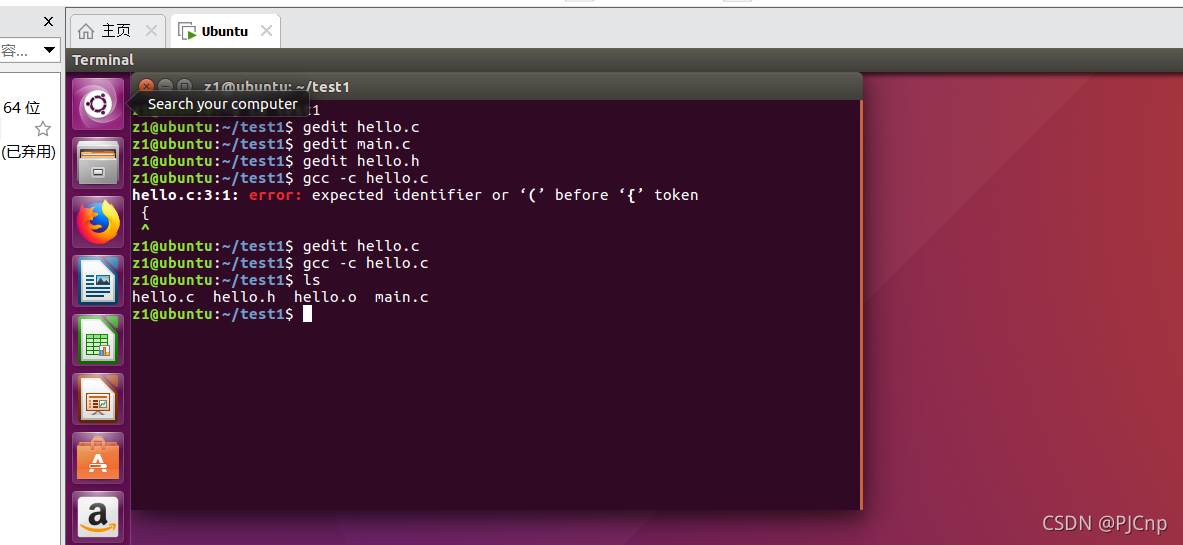目录
一、GCC生成静态库.a与动态库.so
(1)准备过程
1.创建目录
2.创建代码

?hello.h
#ifndef HELLO_H
#define HELLO_H
void hello(const char *name);
#endif//HELLO_Hhello.c
#include<stdio.h>
void hello(const char *name)
{
printf("Hello %s\n",name);
}main.c
#include"hello.h"
int main()
{
hello("everyone");
return 0;
}3.得到.o文件

(2)静态库使用?
1.创建与使用静态库
创建静态库的工具:ar
命名规范:以lib作为前缀,是.a文件
ar -crv libmyhello.a hello.o
gcc -o hello main.c -L. -lmyhello
gcc main.c libmyhello.a -o hello
main.o gcc -c main.c
gcc -o hello main.c libmyhello.a

?(3)验证静态库的特点
在删掉静态库的情况下,运行可执行文件,发现程序仍旧正常运行,表明静态库跟程序执行没有联系。同时,也表明静态库是在程序编译的时候被连接到代码中的。
(3)使用动态库
注意:
创建动态库的工具:gcc
动态文件命名规范:以lib作为前缀,是.so文件
gcc编译得到.o文件 gcc -c hello.c
创建静态库 ar -crv libmyhello.a hello.o
创建动态库 gcc -shared -fPIC -o libmyhello.so hello.o
使用库生成可执行文件 gcc -o hello main.c -L. -lmyhello
执行可执行文件 ./hello
二、使用作业一代码做静态库,动态库比较
1.代码
sub1.c
float x2x(int a,int b)
{
float c=0;
c=a+b;
return c;
}sub2.c
float x2y(int a,int b)
{
float c=0;
c=a/b;
return c;
}sub.h
#ifndef SUB_H
#define SUB_H
float x2x(int a,int b);
float x2y(int a,int b);
#endifmain.c
#include<stdio.h>
#include"sub.h"
void main()
{
int a,b;
printf("Please input the value of a:");
scanf("%d",&a);
printf("Please input the value of b:");
scanf("%d",&b);
printf("a+b=%.2f\n",x2x(a,b));
printf("a/b=%.2f\n",x2y(a,b));
}
?
静态库?
动态库
?
生成文件之间的对比
静态库

?动态库

?静态库与动态库相比较小
三、opencv的编程
?(1)图片
?首先创建一个代码存放在文件夹open
?test.cpp
#include <opencv2/highgui.hpp>
#include <opencv2/opencv.hpp>
using namespace cv;
using namespace std;
int main(int argc, char** argv)
{
CvPoint center;
double scale = -3;
IplImage* image = cvLoadImage("lena.jpg");
argc == 2? cvLoadImage(argv[1]) : 0;
cvShowImage("Image", image);
if (!image) return -1; center = cvPoint(image->width / 2, image->height / 2);
for (int i = 0;i<image->height;i++)
for (int j = 0;j<image->width;j++) {
double dx = (double)(j - center.x) / center.x;
double dy = (double)(i - center.y) / center.y;
double weight = exp((dx*dx + dy*dy)*scale);
uchar* ptr = &CV_IMAGE_ELEM(image, uchar, i, j * 3);
ptr[0] = cvRound(ptr[0] * weight);
ptr[1] = cvRound(ptr[1] * weight);
ptr[2] = cvRound(ptr[2] * weight);
}
Mat src;Mat dst;
src = cvarrToMat(image);
cv::imwrite("test.png", src);
cvNamedWindow("test",1); imshow("test", src);
cvWaitKey();
return 0;
}
?注意:图片名要与cvLoadImage()中一样
运行该程序后会生成 test.png

(2)播放视频
?生成test2.cpp
#include <opencv2/opencv.hpp>
#include<unist.h>
using namespace cv;
int main()
{
//从摄像头读取视频
VideoCapture capture("man.mp4");
//循环显示每一帧
while(1){
Mat frame;//定义一个Mat变量,用于存储每一帧的图像
capture >> frame;//读取当前帧
if(frame.empty())//播放完毕,退出
break;
imshow("读取视频帧",frame);//显示当前帧
waitKey(30);//掩饰30ms
}
pause();
return 0;
}?视频可以自己下载,我准备了自己命名的xxx.cpp
编译 test2.cpp 文件,并运行
g++ test2.cpp -o test2 `pkg-config --cflags --libs opencv`
./test2

(3)录制视频
test3.cpp
#include<iostream>
#include <opencv2/opencv.hpp>
#include<opencv2/core/core.hpp>
#include<opencv2/highgui/highgui.hpp>
using namespace cv;
using namespace std;
int main()
{
//打开电脑摄像头
VideoCapture cap(0);
if (!cap.isOpened())
{
cout << "error" << endl;
waitKey(0);
return 0;
}
//获得cap的分辨率
int w = static_cast<int>(cap.get(CV_CAP_PROP_FRAME_WIDTH));
int h = static_cast<int>(cap.get(CV_CAP_PROP_FRAME_HEIGHT));
Size videoSize(w, h);
VideoWriter writer("RecordVideo.avi", CV_FOURCC('M', 'J', 'P', 'G'), 25, videoSize);
Mat frame;
int key;//记录键盘按键
char startOrStop = 1;//0 开始录制视频; 1 结束录制视频
char flag = 0;//正在录制标志 0-不在录制; 1-正在录制
while (1)
{
cap >> frame;
key = waitKey(100);
if (key == 32)//按下空格开始录制、暂停录制 可以来回切换
{
startOrStop = 1 - startOrStop;
if (startOrStop == 0)
{
flag = 1;
}
}
if (key == 27)//按下ESC退出整个程序,保存视频文件到磁盘
{
break;
}
if (startOrStop == 0 && flag==1)
{
writer << frame;
cout << "recording" << endl;
}
else if (startOrStop == 1)
{
flag = 0;
cout << "end recording" << endl;
}
imshow("picture", frame);
}
cap.release();
writer.release();
destroyAllWindows();
return 0;
}


四、总结
?1.通过三个程序用gcc生成静态库和动态库的练习过程,基本上能够熟练的生成静态库和动态库。在两种库的比较中,能够明显看出两者的差别。虽然,过程中,遇到一些小问题,但是很快就解决了。
2.在opencv的作业过程中需要调整系统设置:
? ? ? ?使用快捷键 Win + R ,输入 services.msc ,并回车。
? ? ??点击 “ 虚拟机 ” ,然后点击 “ 设置(S)… ”。选择 “ USB控制器 ” ,将 “ USB兼容性 ” 设置为 “ USB 3.0 ” ,并点击确定
? ? ??选择 “ 虚拟机 ” ,再选择 “ 可移动设备 ” ,再选择 “ Quanta USB2.0 VGA UVC WebCam ” ,最后点击 “ 连接 ” ,再弹出的窗口内点击 “ 确定 ” 。